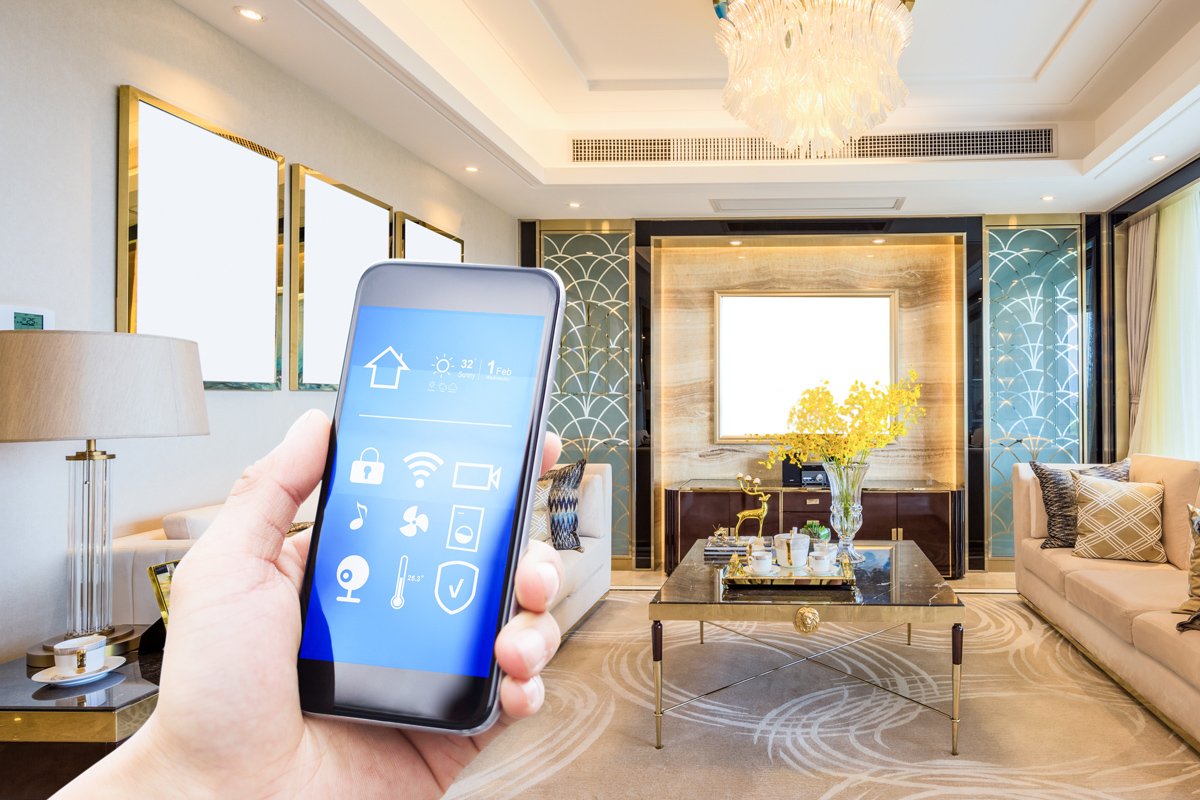
New, highly accessible automated technology has a rapidly accelerated the proliferation of smart homes in America. That’s caused home staging to turn high tech as well. Welcome to the new world of smart home staging.
Here are three things that you need to know about the new trend in showing a home: smart home staging.
1. What Is a Smart Home?
CNET, the leading consumer technology news and review source, worked with Coldwell Banker to create a standard definition of the term “smart home.”
A smart home is defined as “a home that is equipped with network-connected products (i.e., “smart products,” connected via Wi-Fi, Bluetooth or similar protocols) for controlling, automating and optimizing functions such as temperature, lighting, security, safety or entertainment, either remotely by a phone, tablet, computer or a separate system within the home itself.”
Here’s the essential part: to be considered a smart home, a property must have specific features. The most important one: a reliable Internet connection.
Then, it must have either a smart security feature – such as a smart lock, or a network of security cameras – or a smart thermostat. Also, the home must have two other “smart” features located on the list below.
It’s not enough just to have an Amazon Echo or Google Home and call a property a smart home; it actually must meet these new criteria first.
2. How big is the market opportunity for agents?
One of the reasons smart home staging is gaining so much attention is how fast the smart home market is growing. Less than a half-of-one percent of homes in North America had smart home technology, according to tech industry research firm IHS Technology in 2014. Last year, more than one in 10 homes averaged at least six smart home devices.
Amazon reported “tens of millions” of its Echo devices were purchased last year. Its Alexa voice-activated automated assistant can be integrated with more than 4,000 smart home devices from 1,200 different brands – and growing. Google says it sold one of its Google Home smart devices every second since it launched last October. It reports its Assistant can now run on 400 million devices.
As for consumer demand, Lindsey Turrentine, editor-in-chief of CNET.com said, “Eighty-seven (87) percent of Americans acknowledge the value of smart home technology, but only one in four has this technology in their homes.”
A recent T3 Sixty Smart Home survey of brokers and agents found 79 percent said that buyers are willing to pay more for smart homes. One-in-five noted buyers would always be or very willingly pay a smart home premium. Already, 46 percent of brokers and agents said they have recently worked with a seller who had smart home technology or planned to install some to increase curb appeal.
Finally, a Houzz remodeling survey of over 100,000 consumers found that 35 percent of first-time buyers incorporated smart technology into their home renovation. But they were not alone. Nearly one-in-three repeat buyers and 27 percent of long-time homeowners also are investing in smart home products during a renovation.
3. How to Become a Smart Home Stager
Coldwell Banker has been aggressively embracing the smart home staging trend. They have encouraged their agents to take advantage of the current lack of smart home experts in many local real estate markets and become the “go-to smart home expert.” They have published a booklet, “Smart Homes: An Emerging Real Estate Opportunity,” which includes the smart homes research by T3 Sixty.
Key strategies discussed include:
Get in on the conversation: In social media, on Facebook and Nextdoor and other online activities, become a resource and help answer fundamental questions about smart home tech. Write blog posts or give a talk or demonstration on how some of the new basic technology works.
Incorporate it into your marketing: Consumers are interested in smart homes, so tout those features in how you design and communicate in your advertising and promotional pieces. Add additional information to the listing notes. Call out the benefits of the smart home technology, not just the cool features, but what they provide to the homeowner. Add this information to everything from your flyers to your online video tours.
Smart home staging: Once you have the knowledge base, now it’s time to take it to the next level. Create a video that you can play on the home’s largest flat screen TV that talks about all the smart home technology, features and benefits and have that ready to play during open houses and on-demand during showings. Create small display cards that call out smart home tech throughout the house. Let everyone know if smart cameras are on and recording before they walk into the home. And be positive. Have a sign welcoming them to a “Smart home protected by 24/7/365 network video camera security recording.”
Why not a smart home closing gift? An Echo dot or a Google Home Mini are affordable and fabulous gifts that clients will use. Add a device like a Ring doorbell video camera or voice control light. Set them up, and your clients will remember this a lot longer than a gift basket.
For more insight into smart home technology, see:
A Quick Review of Smart Home Technology
How The ‘Internet of Things’ Affects Real Estate
This Is No Fading Fad
With every new tech trend, there’s often a hesitation that this might not last. But home automation and voice-activated control are here to stay. Turning a house into a smart home used to have to start at construction. Now everything is plug-and-play, and any house can almost instantly become a smart home. Smart agents and brokers who seize this new market opportunity earlier rather than later will be the biggest winners.











Comments